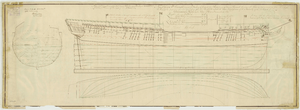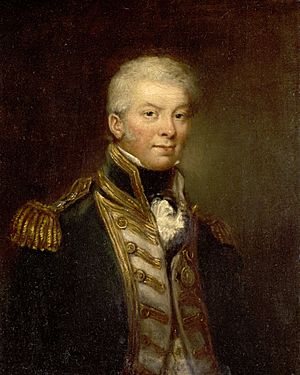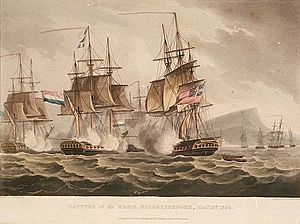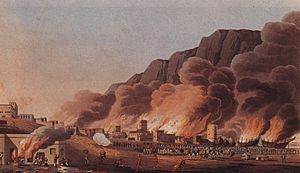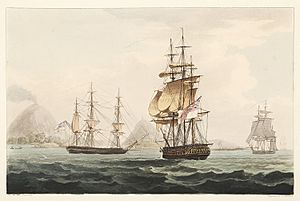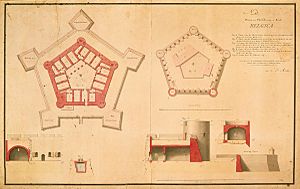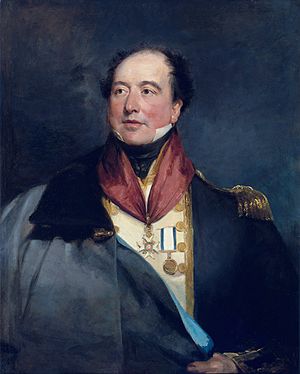HMS Caroline (1795) facts for kids
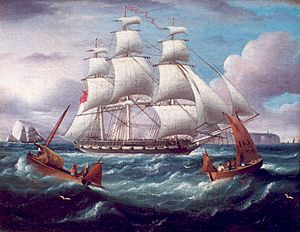
Caroline off Shakespeare Head by Thomas Buttersworth
|
|
Quick facts for kids History |
|
|---|---|
| Name | HMS Caroline |
| Ordered | 24 May 1794 |
| Cost | £24,560 |
| Laid down | June 1794 |
| Launched | 17 June 1795 |
| Completed | 25 September 1795 |
| Commissioned | July 1795 |
| Fate | Broken up September 1815 |
| General characteristics | |
| Class and type | Phoebe-class fifth-rate frigate |
| Tons burthen | 924 44⁄94 (bm) |
| Length |
|
| Beam | 38 ft 3 in (11.7 m) |
| Depth of hold | 13 ft 5+1⁄2 in (4.1 m) |
| Propulsion | Sails |
| Complement | 264 |
| Armament |
|
HMS Caroline was a fast frigate of the Royal Navy with 36 guns. She was built in 1795 and played a big role in the Napoleonic Wars. A frigate is a type of warship that was smaller and faster than a ship of the line, used for scouting, protecting convoys, and raiding enemy ships.
Caroline was designed by Sir John Henslow. She was known for her speed, even though she could be a bit wobbly in the water. For most of her life, she served far from home in the East Indies. There, she helped capture important islands and fought against French and Dutch forces. Her last captain, Sir Christopher Cole, was very successful. Caroline was taken apart in 1815 after a long and busy career.
Contents
Building a Warship: HMS Caroline's Design
Caroline was a 36-gun frigate. She was designed to be a longer version of an older ship called HMS Inconstant. The goal was to make her faster and better at sailing.
The designers made the spaces between the guns wider. This meant some guns had to be placed at the very ends of the ship. Because of this, the ship would sometimes pitch (rock back and forth) quite a lot in rough seas.
Speed and Protection Features
Caroline could sail at about 13 knots, which was fast for her time. However, this speed came with a trade-off: she was not as stable as some other ships. Like many ships built in the 1790s, Caroline had strong walls on her upper decks. These walls protected the crew and provided more places for guns.
Originally, smaller 6-pounder guns were planned for these new spots. But before she was even launched, these were upgraded to 9-pounders. She also got ten powerful 32-pounder carronades, which were short-range cannons.
Building and Armament Details
Caroline was ordered on 24 May 1794 and built in Rotherhithe. Her construction started in June 1794, and she was launched on 17 June 1795. She was 142 feet (43.4 meters) long on her main gun deck. Her widest point, called the beam, was 38 feet (11.6 meters).
The ship was finished and ready for duty on 25 September 1795. Her design and guns did not change much during her service. She carried twenty-six 18-pounder guns on her main deck. On her upper decks, she had eight 9-pounders and six 32-pound carronades. She also had two 9-pounders and four 32-pound carronades on her front deck.
Early Service: From North Sea to Lisbon
Caroline began her service in July 1795 under Captain William Luke. Her first job was with the North Sea Fleet. She worked closely with Admiral Adam Duncan.
In December 1795, she chased and captured a French 14-gun brig called Le Pandore. After less than a year, Caroline moved to the Lisbon Station. This meant she patrolled the waters from Cape Finisterre to the Spanish and Portuguese borders. Her job was to find and stop French ships and protect British merchant ships.
Patrolling and Captures (1796–1797)
In April 1796, Caroline captured an 18-gun French warship. On 23 May, she took a 10-gun French privateer, La Zenodene. A privateer was a private ship allowed by a government to attack enemy shipping.
In August 1796, she sailed into the Mediterranean Sea. There, she helped capture another French privateer, Rochellaire. In November, she captured the Spanish merchant ship Adriana. Her busy schedule continued into 1797. She captured two more Spanish merchant brigs, San Joseph and San Luis. In September, she sailed to the Cape of Good Hope.
Cadiz and More Captures (1798–1799)
Caroline continued her patrols around Cadiz and the Mediterranean. In 1798, she shared in the capture of several merchant ships. She also captured French privateers like Le Francois, Le Fortune, and Le Vainqueur.
On 29 June, she recaptured a British East India Company ship called Crescent. This ship had been taken by a French privateer. On 4 October, while patrolling with another frigate, HMS Flora, Caroline captured the French privateer Le President Parker. This led to a series of successes for Caroline. Her boats destroyed a 1-gun privateer, L'Esperance, and she captured the 10-gun privateer Le Baret.
In November, Captain Lord Henry Paulet briefly took command. Caroline and Flora captured a Spanish merchant ship and a French privateer, La Garonne. Captain William Bowen then replaced Paulet. On 4 December, Caroline captured the 12-gun privateer brig Le Ferailleur by tricking her.
Caroline stayed off Lisbon in 1799. She recaptured the British ship Jane and two other merchant vessels. She also captured French privateers L'Aventure and La Legere. On 24 June, she tracked a French fleet and reported its position. This helped the British chase the French fleet from Brest to the Mediterranean.
Blockade Duty (1800–1801)
On 15 January 1800, Caroline captured the 22-gun privateer Vulture without firing a shot. Vulture had been chasing a merchant brig. The frigate then captured a Danish merchant ship in April.
In late 1800, Caroline joined a squadron blockading Cadiz. A blockade means surrounding a port to stop ships from entering or leaving. On Christmas Day, she captured a French brig carrying cannons. In January 1801, she captured a French privateer. She also stopped a Swedish merchant brig. Caroline continued her duties off Cadiz until December 1801, when she returned to Portsmouth.
Journey to the East Indies
In early 1802, Caroline was taken out of service at Portsmouth. She was repaired and updated at Woolwich until February 1803. She was put back into service on 9 November 1802 under Captain Benjamin William Page.
Caroline was quickly ordered to sail to the East Indies. Her mission was to deliver the news that Britain had declared war on France. She also had orders to stop all Dutch ships. Captain Page had to leave so fast that the ship was not fully ready for such a long journey.
Long Voyage and First Captures (1803)
On 28 May, Caroline saw HMS Victory capture a French frigate. Caroline shared in the prize money from this capture. A day later, she captured a French merchant brig.
On 2 August, off the Cape of Good Hope, Caroline captured a 6-gun Dutch privateer called Haasje. This ship was carrying secret messages from Napoleon to India. The news of war from Haasje caused Dutch ships to be seized and British merchant ships to travel in convoys.
The journey to the East Indies took 103 days, covering 13,000 miles. Caroline only stopped briefly for supplies. Amazingly, no men were lost to sickness on this long voyage. This showed how well-disciplined and clean the ship was. She arrived in the East Indies on 6 September and captured a French merchant ship the next day.
Protecting Convoys (1804)
For several months in early 1804, Caroline escorted convoys through the Bay of Bengal. Convoys are groups of merchant ships traveling together for protection. On 5 January, she captured an 8-gun French privateer called Les Frères Unis.
On 4 February, Caroline found a 26-gun privateer, Le Général du Caen. After a long chase, Caroline used her speed to get close enough to fire. The privateer then surrendered. These captures were important because they stopped these privateers from attacking British merchant ships. Captain Page received valuable swords as a reward from merchant communities in Bombay and Madras.
In March, Caroline became the lead escort for a valuable convoy sailing to and from China. In October, Caroline and the convoy survived a typhoon. During the storm, a sailor fell from the masts. After a dramatic rescue, he and six other men who went to save him all survived. The convoy reached Canton safely and returned in January 1805.
Java Campaign: A Major Battle
In April 1805, Captain Peter Rainier took command of Caroline. She captured a French 14-gun privateer brig that same month.
In October 1806, Caroline was part of a squadron blocking the port of Batavia. A large Dutch fleet there was threatening British merchant ships. On 18 October, Caroline captured a small brig. The crew of this brig told Captain Rainier that a Dutch frigate, Phoenix, was being repaired nearby. Caroline set off to find her.
While searching, Caroline found two Dutch brigs. She captured the 14-gun brig Zeerob. The other brig escaped into Batavia, where it joined Phoenix and other Dutch warships. Phoenix tried to escape, but Caroline entered the harbor. She sailed straight for the 36-gun frigate Maria Reijersbergen, seeing her as the biggest threat.
Caroline fired at Maria Reijersbergen from very close range. After about 30 minutes of intense firing, the Dutch frigate surrendered. The other Dutch ships did not join the fight, making it a fair one-on-one battle. Maria Reijersbergen had 270 men, but Caroline was short 57 men because some were on other ships or in the hospital.
Caroline had three sailors killed and eighteen wounded. The Dutch ship had about 50 men killed or wounded and was badly damaged. Caroline fought in very shallow water, surrounded by dangerous sandbanks. Even though she couldn't chase the other ships, the Dutch ships, including six merchant vessels, ran themselves aground to avoid being captured.
On 27 November, a larger British squadron arrived to finish the job Caroline had started. They couldn't enter the shallow harbor, so they sent boats to attack the beached Dutch ships. The crew of Phoenix sank their own ship, and the British burned all the ships that had escaped Caroline. Maria Reijersbergen was taken into the Royal Navy and renamed HMS Java.
Hunting Dutch Warships (1807)
On 27 January 1807, Caroline was sailing near the Philippines. She spotted a strange ship and chased it. When Caroline got close enough, the ship raised Spanish flags. The enemy ship, though smaller, began to fire. Caroline returned fire, and the ship surrendered after 27 of its crew were killed or wounded.
The captured ship was the 16-gun St. Raphael, sailing as Pallas. She was carrying a huge treasure: 500,000 dollars in silver and 1,700 quintals (about 170,000 pounds) of copper. Caroline had only seven men wounded in this capture. However, many of her crew were sick, so she returned to port with only a small number of healthy sailors.
By June, Caroline was with Admiral Edward Pellew's squadron. She was sent with another frigate to find two Dutch warships that had escaped from Batavia. On 29 August, they found out the Dutch ships were in bad shape in the port of Gresik.
On 31 August, Caroline shared in the capture of the Dutch corvette Scipio. In September, Commander Henry Hart became Caroline's acting captain. On 20 October, the squadron left for Gresik.
Attack on Gresik (1807)
The squadron arrived on 5 December and attacked the port on 11 December. Caroline became Admiral Pellew's temporary flagship when his own ship got stuck. Caroline was right behind his ship and almost crashed into it. But quick thinking with an extra anchor saved Caroline from hitting the flagship.
The squadron then burned three Dutch warships and a large merchant ship, all of which the Dutch had sunk to prevent capture. They also destroyed the fort, its gun batteries, and the dockyard. Commander Hart led the landing party and the attack on the port's buildings.
This action meant the Dutch no longer had an active navy in the East Indies. The local leaders agreed to help the British with supplies to stop further destruction. After getting supplies and making repairs, the ships left Gresik on 17 December. Caroline then fought against shore batteries and gunboats at the entrance of Manila Bay. Even after four years in the hot climate, the crew still struggled with the heat and diseases.
Persian Gulf and Spice Islands
In early 1808, Caroline captured two merchant ships. On 21 December, Captain Charles Gordon took command. The frigate moved to the Persian Gulf in November 1809 to fight pirates.
That same month, Caroline helped destroy over eighty pirate ships at Ras-al-Khyma. This was a well-known pirate base. Caroline sailed with another frigate and several ships from the Bombay Marine. The smaller ships bombarded the coast on 12 November. Then, troops, including Captain Gordon and marines from Caroline, landed on 13 November.
By 10 a.m., the town was captured. By 4 p.m., all the pirate ships and naval storehouses were burned and destroyed. The troops left on 14 November. Caroline had only one man injured in this attack. One of her lieutenants later died from an illness caught during the fighting.
Capturing Banda Neira (1810)
In early 1810, Captain Christopher Cole took command of Caroline. She briefly served as the flagship for Admiral William O'Bryen Drury. On 10 May, Caroline became the lead ship of a squadron. This group included another frigate, a brig-sloop, and a gun-brig.
The gun-brig carried 100 soldiers, money, and supplies for a recently captured island. On the way, the squadron stopped to pick up artillerymen, two field guns, and twenty scaling ladders. Their goal was to attack Banda Neira, a heavily guarded island.
The squadron reached Banda Neira on 8 August. They tried to enter the harbor at night but were fired upon and had to retreat. Instead, small boats were launched with soldiers and sailors. The weather turned bad with rain and thunder, scattering many boats. Only 200 men, with just 40 soldiers, were left for the attack.
A full-scale attack was impossible, so the boats aimed for two gun batteries. The Dutch expected a landing in a different spot, so the attackers had the element of surprise. They landed in the rain and quickly took a 10-gun battery without any losses. Twenty minutes later, they attacked Fort Belgica, a major fort with 52 cannons.
The attack was successful when they scaled the outer walls. The rain made it hard for the Dutch to fire their cannons. The attackers rushed the main gate, which had been opened for Dutch officers. The fort's commander and ten Dutch soldiers were killed, and many others were captured.
In the morning, the ships entered Banda Neira's harbor with Caroline in the lead. The remaining batteries fired, but shots from the captured Fort Belgica and a threat to storm Fort Nassau ended the island's defense. The British captured 120 guns and 700 Dutch soldiers without losing a single man.
Caroline's first lieutenant, John Gilmour, commanded the frigate while Captain Cole was ashore, even though he was very ill. He later took the captured flags to Admiral Drury. Captain Cole received a silver cup and two swords as gifts for this victory. The capture was worth a lot of money, especially from the valuable spices found there. Caroline sailed for Madras on 15 August for repairs. In September, she brought the new governor to Banda Neira.
Invasion of Java and Return Home
In 1811, Caroline joined Admiral Drury's forces to prepare for an attack on Java. On 6 March, Admiral Drury suddenly died. Captain Cole continued the preparations until other senior officers arrived later that year. By the time they arrived, Cole had almost finished getting everything ready for the invasion.
On 4 August, a large force arrived at Chillingching Bay, east of Batavia. Caroline was the lead frigate, tasked with covering the landing of the invasion forces on the beaches. They found no enemy forces defending the landing site. Two gun batteries meant to guard the area were unfinished. So, Captain Cole ordered 8,000 men to land immediately from the frigates' boats. They landed successfully before the Dutch could respond. Caroline did not take part in further fighting during the invasion.
Captain Cole was personally thanked for his actions by the Governor-General of India Lord Minto. The invasion was a success. Caroline was chosen to take the news of the victory back to Britain. She arrived on 15 December, completing the voyage in 94 days. This was one of the fastest trips from the East Indies at that time. Captain Cole was knighted in 1812 for his service. The crew of Caroline gave him a sword and a letter thanking him for his kindness and bravery.
End of Service
After her long service, Caroline was taken out of active duty at Portsmouth in January 1812. In November 1813, she was used as a salvage ship. Her job was to help lift the wreck of a large 100-gun warship, HMS Queen Charlotte, which had exploded in 1800. Caroline was finally taken apart at Deptford in September 1815.
Prizes Captured by Caroline
| Ships captured or destroyed by Caroline | |||||
|---|---|---|---|---|---|
| Date | Ship | Nationality | Type | Fate | Ref. |
| 1 December 1795 | Le Pandore | 14-gun brig | Captured | ||
| April 1796 | Not recorded | 18-gun corvette | Captured | ||
| 23 May 1796 | La Zenodene | 10-gun privateer polacre | Captured | ||
| 20 August 1796 | Rochellaire | Privateer | Captured | ||
| 5 November 1796 | Adriana | Merchant vessel | Captured | ||
| 16 February 1797 | San Joseph | Merchant brig | Captured | ||
| 5 July 1797 | San Luis | Merchant brig | Captured | ||
| 18 February 1798 | Umbarca Souda | Merchant vessel | Captured | ||
| 27 February 1798 | El Carmen | Privateer | Captured | ||
| 26 April 1798 | Constanza | Merchant vessel | Captured | ||
| 19 March - 26 April 1798 | Le Francois | Privateer | Captured | ||
| 19 March - 26 April 1798 | Le Fortune | Privateer | Captured | ||
| 19 March - 26 April 1798 | Le Vainqueur | Privateer | Captured | ||
| 9 May 1798 | Strella de Mare | Merchant vessel | Captured | ||
| 29 June 1798 | Crescent | Merchant vessel | Recaptured | ||
| 21 July 1798 | Il Terrice | Merchant vessel | Captured | ||
| 18 September 1798 | Virgin d'Idra | Merchant vessel | Captured | ||
| 4 October 1798 | Bird | Merchant vessel | Recaptured | ||
| 4 October 1798 | Le President Parker | 12-gun privateer | Captured | ||
| 16 October 1798 | L'Esperance | 1-gun privateer | Destroyed | ||
| 20 October 1798 | Le Baret | 10-gun privateer | Captured | ||
| 20 October 1798 | Nostra Senora de Misericordia | Merchant vessel | Captured | ||
| 20 October 1798 | San Joseph | Merchant vessel | Captured | ||
| 21 November 1798 | El Bolante | Merchant vessel | Captured | ||
| 23 November 1798 | La Garonne | 10-gun privateer | Captured | ||
| 4 December 1798 | Le Ferailleur | 12-gun privateer brig | Captured | ||
| 25 January 1799 | L'Intrepide | Privateer | Captured | ||
| 27 January 1799 | Jane | Letter of marque | Recaptured | ||
| January 1799 | Drie Vrienden Hoy | Merchant vessel | Recaptured | ||
| January 1799 | Nymph | Merchant vessel | Recaptured | ||
| 14 February 1799 | L'Aventure | Privateer | Captured | ||
| February 1799 | Six Sisters | Merchant vessel | Recaptured | ||
| 19 April 1799 | La Legere | Privateer | Captured | ||
| 31 August 1799 | La Resolve | Privateer | Captured | ||
| 26 December 1799 | El Fleche | Privateer | Captured | ||
| 26 December 1799 | La Voiture | Privateer | Captured | ||
| 15 January 1800 | La Ventour | 22-gun privateer | Captured | ||
| 8 April 1800 | Young Johannes | Merchant vessel | Captured | ||
| 25 December 1800 | Good Friends | Merchant brig | Captured | ||
| 21 January 1801 | Le Regulus | 4-gun privateer xebec | Captured | ||
| 1 February 1801 | Active | Merchant brig | Detained | ||
| 5 October 1801 | Prince of Wales | Merchant vessel | Recaptured | ||
| January–February 1802 | Tito | Merchant vessel | Captured | ||
| 28 May 1803 | L'Ambuscade | 32-gun frigate | Captured | ||
| 29 May 1803 | La Bonne Mere | Merchant brig | Captured | ||
| 2 August 1803 | Haasje | 6-gun privateer | Captured | ||
| 3 August 1803 | Henrica Johanna | Merchant vessel | Detained | ||
| 7 September 1803 | Petite Africaine | Merchant vessel | Captured | ||
| 5 January 1804 | Les Frères Unis | 8-gun privateer | Captured | ||
| 4 February 1804 | Le Général du Caen | 26-gun privateer | Captured | ||
| April 1805 | Gautavie | 14-gun privateer brig | Captured | ||
| 18 October 1806 | Not recorded | Merchant brig | Captured | ||
| 18 October 1806 | Zeerob | 14-gun brig | Captured | ||
| 18 October 1806 | Maria Reijersbergen | 36-gun frigate | Captured | ||
| 18 October 1806 | Phoenix | 36-gun frigate | Destroyed | ||
| 18 October 1806 | William | 20-gun gun-sloop | Destroyed | ||
| 18 October 1806 | Patriot | 18-gun sloop | Destroyed | ||
| 18 October 1806 | Zeeplong | 14-gun brig | Destroyed | ||
| 18 October 1806 | Not recorded | Merchant vessel | Destroyed | ||
| 18 October 1806 | Not recorded | Merchant vessel | Destroyed | ||
| 18 October 1806 | Not recorded | Merchant vessel | Destroyed | ||
| 18 October 1806 | Not recorded | Merchant vessel | Destroyed | ||
| 18 October 1806 | Not recorded | Merchant vessel | Destroyed | ||
| 18 October 1806 | Not recorded | Merchant vessel | Destroyed | ||
| 27 January 1807 | St Raphael | 16-gun treasure ship | Captured | ||
| 31 August 1807 | Scipio | 18-gun corvette | Captured | ||
| 11 December 1807 | Revolutie | 68-gun ship-of-the-line | Destroyed | ||
| 11 December 1807 | Pluto | 68-gun ship-of-the-line | Destroyed | ||
| 11 December 1807 | Kortenaar | 68-gun sheer hulk | Destroyed | ||
| 11 December 1807 | Ruttkoff | 40-gun merchant vessel | Destroyed | ||


